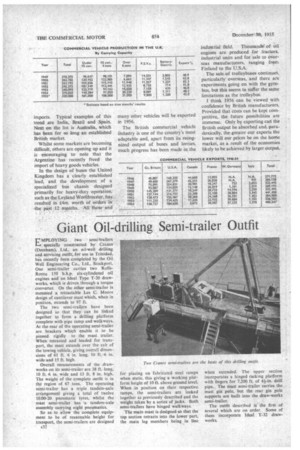Bigger and Better Vehicles
Page 33

Page 34

If you've noticed an error in this article please click here to report it so we can fix it.
says D. G. Stokes, General Sales and Service Manager, Leyland Motors, Ltd.
MORE than a crystal ball is required to forecast the prospects of the commercialvehicle -industry for 1950. When it
is considered that over 50 per cent. of the ' output of the leading manufacturers is being exported to some 40 overseas territories, quite apart from the complexities of the home market, the problems involved in looking into the future will . be appreciated.
On the home market the position is clearer, with most manufacturers having more-than-full order books. The Commercial Motor Show next autumn will see a synthesis of ideas arising out of recent legislation that must have a decided influence on the future.
On the goods side will be seen the results of the increased gross vehicle weights now permissible and, who knows, it might be that 30 m.p.h. for heavies will have come at last. Possibly one of the most significant developments will be the increasing use of articulated vehicles, and important experiments are in hand 'n
this connection by British Road Services.
That the oiler has come to stay in all ranges is obvious, but in some of the lighter ranges interesting alternatives are being offered, with small underfloor engines giving greater available carrying space within smaller overall areas for the lighter delivery vehicles.
At home, the underfloor oil engine is now firmly established for singledeck buses and coaches. With little possibility of fuel-tax relief, the search for even greater economy continues. More power is being developed by smaller-capacity engines, and greater reliability and mileage between overhaul periods are resulting from much intensive research and development work.
At long last an overall length of 30 ft. is going to be permitted in 1956 for double-deckers, and a range of new models with wheelbascs of 18 ft. 5 in or more will be introduced to cope with this development, although a few V manufacturers already build such models for export. The increased loading of these larger double-deckers will establish the larger engine and undoubtedly call for greater use of automatic and semi-automatic transmissions.
With the tilting angle remaining at the old figure there should be much greater use of plastics and other lightweight material by bodybuilders, particularly for double-deck bodywork, as more 73-seaters can confidently be expected on the roads in large numbers in the coming year.
The export field presents many more opportunities for speculation, each market having its own design, marketing and legislative problems. The .development of road transport overseas has exceeded all estimates, even allowing for replacement of arrears of vehicles accumulated during the war. Progress in underdeveloped countries Continues at fantastic rates and is accompanied by substantial improvements in road transport for both goods and passengers.
One of the most encouraging signs is the increasing demand for Cite heavier arid more economical type of vehicle, for which Great Britain has obtained such a good reputation as a manufacturer. The size and power output of export vehicles is expanding, together with a demand for easy-change transmission systems designed for unskilled drivers.
Oil Engines Popular
Abroad, the oil engine is as popular as ever and is now demanded as much for its reliability and trouble-free operation as for its known economy.
The British manufacturer has made great progress in these overseas markets, but not without serious competition from the ,U.S.A. and the Continent. , The lead obtained by this country, can be maintained and improved, provided that our prices can be kept competitive. The margin today is narrow and any substantial wage award in the engineering and allied industries could well make thefl United kingdom product toci expensive to be considered by foreign buyers.
Apart from competition by estab, lished manufacturers, many Countries are insisting on indigenous manufacture, so as to use local labour and because road transport is too vital an instrument in the national economy to be entirely dependent on imports. Typical examples of this trend are India, Brazil and Spain. Next on the list is Australia, which has been for so long an established British market.
Whilst some markets are becoming difficult, others are opening up and it is encouraging to note that the Argentine has recently freed the import of heavy goods vehicles.
In the design of buses the United Kingdom has a clearly established lead, and the development of a specialized bus chassis designed primarily for heavy-duty operation, such as the Leyland Worldmaster, has' resulted in £4m. worth of orders in
the past 12 months. , All .these and
_ . many other vehicles will be exported in 1956.
The British commercial vehicle industry is one of the country's most adaptable and, apart from its recognized output of buses and lorries, much progress has been made in the industrial' field. Thousands j of oil engines are produced for tractors. industrial units and for sale to Overseas manufacturers, ranging from Finland to the U.S.A.
The sale of trolleybuses continues, particularly overseas, and there are experiments going on with the gyrobus, but this seems to suffer the same limitations as the trolleybus.
think 1956 can be viewed with confidence by British manufacturers Provided that costs can be kept competitive, the future possibilities are immense. Only by exporting can the British output be absorbed and, paradoxically, the greater our exports the lower will our prices be on the home market, as a result of the economies likely to be achieved by larger output.




















































































